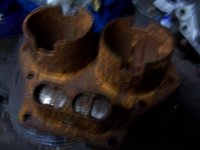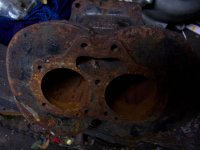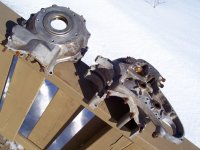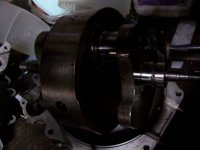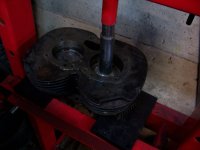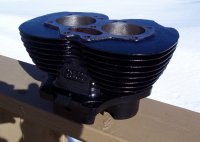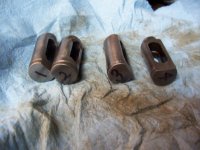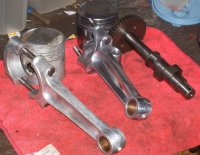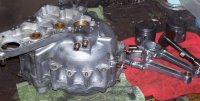I really didn't expect to get too many people interested in this, but I guess there is enough to get it under way.
This project came to me in the form of five plastic milk crates and three cardboard boxes full of bits and pieces from several different engines...some look good, some, not so good. Some parts from the older iron head engines, some from the later aluminum head machines. This engine will be going in a '56 Golden Flash and so one will use the aluminum head (I hope).
To start with, I decided to have a look at the best looking crankshaft and crankcase. There was is a good bit of rust on the crankcase fasteners, but all things considered, it didn't look too ugly. The crank was lightly rusted, but the clean out plugs came out very easily to reveal a clean oil passage. After spending a few hours cleaning it up, the crankshaft looked almost as good as new...there was no indication of any sort of wear on the journals or the main bearing and timing side bushing. In fact, when I measured everything up, they all came to a perfect 0.30 under regrind. I began to think that someone may have been in the process of getting it ready for re assembly.
The cylinders I took out of the shed first, appeared to be in pretty nice condition, but both pistons were stuck in the bores...No problem says I, but when I got this fused together mess in the shop I was not too delighted to see that the cylinder walls, in spite of being relatively clean, were very badly pitted. The pistons are marked as 0.060" over and would not budge even with the help of the hydraulic press...I'll get them out eventually and I may consider getting them rebored to 0.080" for some other project, but for now they are 'soaking'.
Enter the rusty jugs in the previous posting. As I was digging through the boxes, I discovered a brand new set of pistons among the other offerings and began to wonder...why did he buy new pistons? I looked at the horridly rusty cylinders sitting in the 'unservicable' pile and slipped the top of one of the pistons into the bores. I have seen rebored cylinders left to rust before, but I have never seen anything so horrid looking as this set. Just for curiousity, I thought I would try cleaning them up. It took a whole day of scrubbing, honing and sanding, but they are almost as good as new...I even managed to get the tappets out of their bores and they cleaned up perfectly. I still don't understand why someone would take a freshly rebored cylinder and let it sit on the floor of a basement that regularly floods, without even bothering to grease it up. I got a history lesson the other day on these particular bits and pieces, but this is getting a little long winded, so I'll save that story for another post. Here's what I've got so far:
Crankcase halves, crankshaft, seized pistons/ cylinders (cleaned up), cleaned up tappets:


